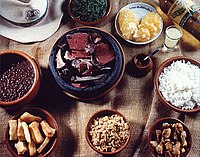
Photo from wikipedia
The study was carried to process, produce, and evaluate nutritional contents of traditional couscous from sprouted wheat (Triticum aestivum), fortified with Soya bean (Glycine max) and Pumpkin (Cucurbita pepo) seeds.… Click to show full abstract
The study was carried to process, produce, and evaluate nutritional contents of traditional couscous from sprouted wheat (Triticum aestivum), fortified with Soya bean (Glycine max) and Pumpkin (Cucurbita pepo) seeds. The composite couscous blends were traditionally produced and compared with commercial couscous. The sprouted wheat couscous blends were blended in different ratios, they include; unprocessed (Raw wheat, 100), blend 1 (sprouted wheat mixed with soya bean and pumpkin seeds, 70:20:10), blend 2 (sprouted wheat mixed with soya bean, 60:40) and blend 3 (sprouted wheat mixed with pumpkin seeds, 60:40). Traditional wheat couscous blends were fed to experimental albino rats of wister strain weighing between (35 g and 45 g) for a period of 28 days. The nutritional and physiochemical analysis were determined using standard laboratory methods. The Statistical Package for Social Sciences (SPSS), version 20.0 was used to analyze the data collected which were expressed as means ± SE. One way analysis of variance (ANOVA) and Duncan’s multiple range tests were used to compare the means obtained after each experiment. Differences were considered significant at p < 0.05. Processing (Sprouting) decreases the levels of anti-nutrients, mineral elements and vitamins. Supplementation with soya bean and pumpkin seeds increased the nutritional composition of the sprouted wheat couscous blends. Results of chemical composition showed that blend 2, recorded high protein (29.95%), fat (8.95%) and low carbohydrate content (49.56%), followed by blend 1 and then blend 3, while commercial couscous crude protein, fat and carbohydrate were 12.53%, 1.42% and 75.10% respectively. There was improved level of in vitro protein digestibility at 1 hour (76.64% to 98.59%) and at 6 hours (96.80% to 99.33%). Results of in vivo studies showed that raw wheat couscous recorded protein quality when compared with spouted wheat couscous blends produced. The biological values of the composite couscous blends range from 95.04% to 95.73% and blend 2, recorded high net protein utilization (98.57%). In terms of sensory evaluation using hedonic method, blend 2 was most acceptable and differ significantly (p < 0.05) with other sprouted wheat couscous blends and commercial couscous. The cost of producing sprouted wheat couscous blends is cheaper than the commercial couscous. The study has therefore, revealed that with proper selection of locally available cereal, it is possible to produce nutritious complementary couscous blends that would be acceptable and nutritionally adequate to meet up the nutritional requirement for both children and adults. It also compares favourably with the commercial couscous in terms of nutrient contents.
Journal Title: Food Science and Nutrition
Year Published: 2020
Link to full text (if available)
Share on Social Media: Sign Up to like & get
recommendations!